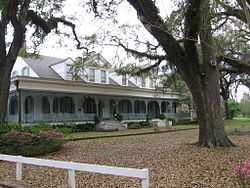Myrtles Plantation
|
Myrtles Plantation | |
 | |
 | |
| Location | U.S. 61, St. Francisville, Louisiana |
|---|---|
| Coordinates | 30°48′11″N 91°23′15″W / 30.80306°N 91.38750°WCoordinates: 30°48′11″N 91°23′15″W / 30.80306°N 91.38750°W |
| Area | 10 acres (4.0 ha) |
| Built | 1796 |
| Governing body | Private |
| NRHP Reference # | 78001439[1] |
| Added to NRHP | September 6, 1978 |
The Myrtles Plantation is an antebellum plantation in St. Francisville, Louisiana, near Baton Rouge. Listed on the National Register of Historic Places. The plantation is rumored to be on top of an ancient Tunica Indian burial ground. It is currently a bed and breakfast, and offers historical and mystery tours.
History
The Myrtles Plantation was built in 1796 by General David Bradford and was called Laurel Grove at the time. General Bradford lived there alone for several years, until President John Adams pardoned him for his role in the Pennsylvania Whiskey Rebellion. He then moved his wife Elizabeth and their five children to the plantation from Pennsylvania. David Bradford died in 1808.[2] In 1817, one of Bradford's law students, Clark Woodruff (or Woodroff) married Bradford's daughter, Sara Mathilda. Clark and Sara Woodruff managed the plantation for David Bradford's widow, Elizabeth. The Woodruffs had three children: Cornelia Gale, James, and Mary Octavia.[3] Sara Bradford Woodruff and two of her three children died in 1823 and 1824 of yellow fever.[3][4]
When Elizabeth Bradford died in 1831, Clark Woodruff and his surviving daughter Mary Octavia moved to Covington, Louisiana, and left a caretaker to manage the plantation. In 1834, Woodruff sold the plantation, the land, and its slaves to Ruffin Gray Stirling. Woodruff died in New Orleans in 1851.
Stirling and his wife, Mary Catherine Cobb, undertook an extensive remodeling of the house. When completed, the new house was nearly double the size of the former building, and its name was changed to The Myrtles. They imported fancy furniture from Europe. The Stirlings had nine children, but five of them died young. Stirling died in 1854 and left the plantation to his wife.[3]
In 1865, Mary Cobb hired William Drew Winter to help manage the plantation as her lawyer and agent. Winter was married to Mary Cobb's daughter, Sarah Stirling. Sarah and William Winter lived at the Myrtles and had six children, one of whom (Kate Winter) died from typhoid at the age of three. Although the Winters were forced to sell the plantation in 1868, they were able to buy it back two years later.[3]
In 1871, William Winter was shot on the porch of the house, possibly by a man named E.S. Webber,[5] and died within minutes. Sarah remained at the Myrtles with her mother and siblings until 1878, when she died. Mary Cobb died in 1880, and the plantation passed to Stephen, one of her sons. The plantation was heavily in debt, however, and Stephen sold it in 1886 to Oran D. Brooks. Brooks sold it in 1889, and the house changed hands several times until 1891, when it was purchased by Harrison Milton Williams.[3]
20th century
In the early part of the 20th century, the land surrounding the house was divided among the heirs of Harrison Milton Williams. In the 1950s, the house itself was sold to Marjorie Munson, who apparently noticed odd things happening around the area surrounding the Myrtles. The plantation went through several more ownership changes in the 1970s before being bought by James and Frances Kermeen Myers.[6] The Myers ran the plantation as a bed and breakfast.[7] Frances Myers, writing as Frances Kermeen, wrote a book about Myrtles Plantation, naming it as the most haunted house in America.[6][8]
Legends and ghost stories

Touted as "one of America's most haunted homes",[7] the plantation is supposedly the home of at least 12 ghosts.[9] It is often reported that 10 murders occurred in the house,[9] but historical records only indicate the murder of William Winter.[3] William Drew Winter is also a very popular character in the plantation. He was an attorney who lived in the plantation from 1865 until 1871. He was shot by a stranger. After being shot, he staggered inside the house and died trying to climb the stairs. He died on the 17th step of the stairs. Until today, visitors, as well as employees in the hotel, still hear his dying footsteps.[10]
In 2002, Unsolved Mysteries filmed a segment about the alleged hauntings at the plantation. According to host Robert Stack, the production crew experienced technical difficulties during the production of the segment. The Myrtles was also featured on a 2005 episode of Ghost Hunters.[11][12]
References
- ↑ "National Register Information System". National Register of Historic Places. National Park Service. 2009-03-13.
- ↑ - National Park Service "Explore the History and Culture of Southeastern Louisiana"
- ↑ 3.0 3.1 3.2 3.3 3.4 3.5 - America's Most Haunted: Myrtles Plantation
- ↑ - "Haunted Plantation - Myrtles Plantation Bed and Breakfast, St. Francisville, Louisiana" by Joe Nickell, Skeptical Inquirer, Septempter-October 2003, retrieved July 18, 2006
- ↑ "PrairieGhosts: Myrtles Plantation". Retrieved March 14, 2013.
- ↑ 6.0 6.1 "Natchez Area Paranormal Society - Historical Archives".
- ↑ 7.0 7.1 "Myrtles Plantation".
- ↑ Kermeen, Frances. Myrtles Plantation, the True Story of Americas Most Haunted House.
- ↑ 9.0 9.1 Myrtles Plantation Bed and Breakfast Haunted House
- ↑ Ghosts of Myrtles Plantation HauntedRooms.com
- ↑ "Ghost Hunters". SciFi Channel. Season 2. Episode 201. 2005-07-27.
- ↑ Hawes, Jason; Wilson, Grant; Friedman, Michael Jan (2007). "The Myrtles February 2005". Ghost Hunting: True Stories of Unexplained Phenomena from The Atlantic Paranormal Society. New York: Pocket Books. pp. 135–147. ISBN 978-1-4165-4113-4. LCCN 2007016062.
External links
- official Myrtles Plantation website -
- official Unexplained Apparitions Research Society website
- Unexplained paranormal investigative team's Myrtles Plantation field reports
| ||||||||||||||||||||||||||